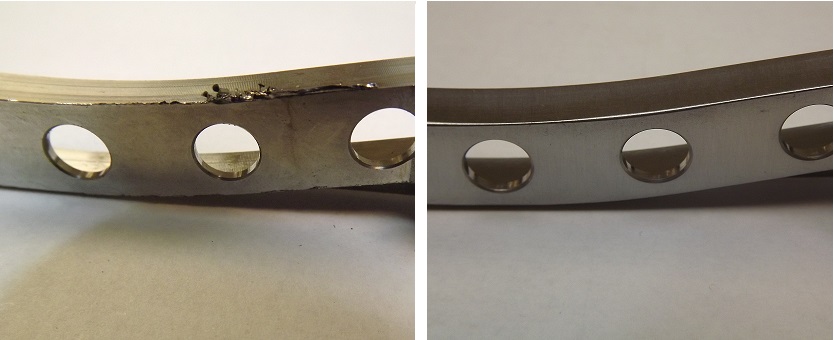Efficient Deburring for Quality Finished Parts
 R.P Abrasives leads the industry with innovative finishing techniques and processes which transform and improve the surface of metal and plastic parts and components. One of our most popular finishing services is deburring.
R.P Abrasives leads the industry with innovative finishing techniques and processes which transform and improve the surface of metal and plastic parts and components. One of our most popular finishing services is deburring.
What is Deburring?
Deburring is a process used to remove pieces of material from the surface of a metal or plastic part. These unwanted pieces are referred to as “burrs,” which may occur because of dull tooling or because an area is difficult to reach using conventional machine deburring. Often they are removed during the machining process like milling, grinding, and turning by adding a deburring tool or brush in the machine's tool holder. A finishing or deburring step must be added when a burr cannot be removed during machining.
This is where RPA comes in as we assess the problem and decide the best method for burr removal while holding all the part tolerances. It might be removed by hand, tumbling, bead blasting, or perhaps a combination of several steps. Deburring services are employed when clients require their product, part, or component to be smoother and free of bumps and jagged pieces (burrs). Burr removal is one of the most popular metal finishing processes because manufacturers in nearly every industry require their products to meet certain specifications for safety, aesthetic quality, and functionality.
Our Deburring Capabilities
Some of the most common concerns about deburring are whether burrs can be removed from hard-to-reach areas and if deburring will compromise the integrity or tolerance of the part. By using a combination of advanced mechanical processes, burrs can be removed, and the desired finish can be achieved without compromising the part. Using innovative technologies like microscopic deburring and high-resolution micro cameras, even the smallest parts and components can be effectively deburred. A Quality Control Department thoroughly examines all deburred parts to ensure all tolerances and specifications meet our high standards.
Types of Deburring Processes
Since all parts are different and every client has different needs, burr removal techniques and processes are tailored to each specific product.
For hand deburring, various tools are used, some of which are handheld and others mechanical. Tools like a buffing jack and non-woven wheel can be used with small hand-held tools to get into difficult crevices, achieving a precise result that machines alone couldn’t produce.
Batch deburring, also known as “mass finishing,” begins with tumbling, a process that achieves overall smoothness. Different types of tumblers are used depending on the size of the part or the number of parts to be tumbled. Tumbler types include vibratory - which uses vibration to tumble the parts, high energy, and centrifugal. If tumbling isn’t an option, parts can also be deburred with basket blasting (sometimes called tumble blasting) where parts are held in a mesh basket while being “blasted” with abrasive material, or ultrasonic deburring, which blasts away burrs with ultrasonic energy.
Request a Deburring Quote from RP Abrasives
Looking for deburring services for your part? Request a quote below from RP Abrasives! If you have additional questions about the deburring process or which type of deburring will be best for your part, or product component, please feel free to contact us today.
